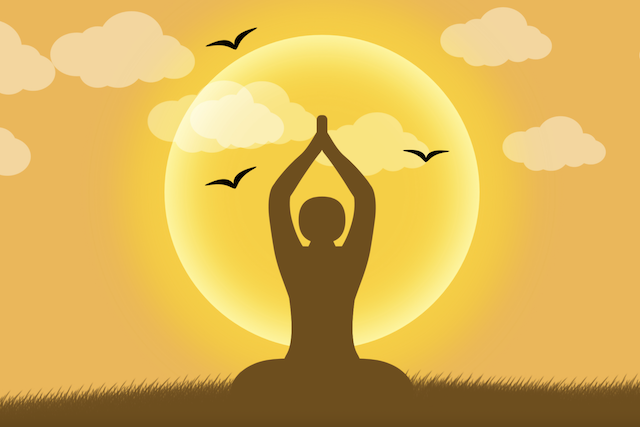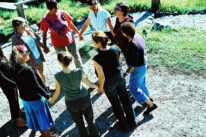
“Embodiment is living within, being present within the internal space of the body.” ~Judith Blackstone
When I was a little boy, I would dance whenever I heard a catchy pop song on the radio. There are photos of me throwing down dance moves, exuding joy and vitality. At some point, though, I lost my ability to dance.
If I were to guess what happened, I would say that I stopped dancing when I became self-conscious. I was no longer just being; suddenly, I became aware of being someone with a body.
So a long and complicated relationship with my body began. As a teenager, friends and family teased me for being unusually tall and gangly. As a young man struggling with my queer identity, I objectified my body; I felt ashamed of how ‘it’ strayed so far from the perceived masculine ideal. To make matters worse, one day my lungs spontaneously collapsed.
Over the course of two years or so, I was in and out of hospitals as doctors struggled to fix my leaky lungs. Undergoing multiple painful surgical procedures, I experienced my body as a source of great emotional and physical pain.
Life presented other challenges. In time, I concluded that being in a body in this world is inherently painful. I thought that in order to find peace, I had to become free of pain. To achieve this, my mind had to separate itself from bodily experience.
Seeking a Way Out
In my early twenties, I was already weary of life. Feeling alienated, I retreated into my inner world of ideas and concepts, where I could indulge in fantasy and philosophy through reading. Most of the time, I was just a head in front of a screen, browsing the internet—there was little sense of having a body.
I also tried many things to minimize my exposure to pain and fear. Evading social interactions to evade the possibility of experiencing shame was a common strategy of mine. I was deathly afraid of feeling difficult emotions. Being a highly sensitive person, powerful emotions like shame would shut me down, leaving me incapacitated.
Later, I embarked on a spiritual journey and became drawn to teachings that promised an end to suffering. I poured myself into meditation and became somewhat relieved by a growing sense of detachment. I thought it was a mark of progress, but actually, I was becoming more apathetic. Increasingly, I had difficulty engaging with life and other people.
Recovering Authenticity and Aliveness
Living inside my head, I became an observer of life—like an armchair anthropologist. Sure, I participated in the activities that society expected of me, but I always did so at a distance.
We all come into this world as embodied consciousness. With our body we experience ourselves and contact our environment: we move, communicate, relate, and create worlds. We experience the world’s colors, melodies, temperatures, pulsations, and textures. And it is through our body that we feel joy, sadness, anger, fear, comfort, and love. Through tasting this smorgasbord of sensations, we also discover and bring out our unique expression into the world.
Life with limited sensation and feeling is like experiencing the world in one dimension only. So, the work I had to do to find myself again involved coming home to my body.
In a world that sometimes tries to erase or suppress our embodied, authentic expression, coming home to ourselves requires courage and a lot of support. By reclaiming our body, we can rediscover a sense of belonging in ourselves and in this world.
5 Ways to Begin Coming Home to Your Body
There are many approaches that can help us come home to our body and feel more alive. If you’ve experienced deep trauma, please find a trained somatic practitioner who can work with you. Here, I’ll just share a few simple things you can try doing more of to become a little more embodied. Make sure to listen to your body in order to discern whether these activities feel right for you.
1. Breathe deeply.
Proper breathing is essential to becoming more embodied.
I learned from a bodyworker that I wasn’t breathing fully most of the time. My Zen practice taught me to breathe into my belly, but now, I wasn’t breathing into my chest much.
To breathe more fully, breathe in deeply, filling the space in your abdomen as if you were pouring water into a jug. The air rises up to the chest as water rises up a jug. Breathing out, the air releases from the chest and from the belly.
2. Touch the earth.
Recently, my painting teacher offered to teach me how to garden. There’s something very healing about touching the soil with my hands. When we touch the earth, we connect with our larger body, which helps us recognize our individual small body.
Today, so many of us, including myself, spend our days sitting in front of a computer. So I think it’s important to find activities where we can touch the earth. I remember the first time I walked on a beach with my bare feet, I thought to myself, “Wow! I can really feel my legs and feet… I feel so alive.”
3. Nourish with quality food.
One of the healers I worked with taught me that what we eat has enormous effects on our psychosomatic system on multiple levels. I’m not a specialist in this area, but from my experience, switching to a healthier diet was a game changer.
It’s not just what we eat, but how we eat, too. By expressing gratitude for what I am eating and savoring the delicious sensations on my tongue, I celebrate the experience of being embodied.
4. Move freely.
Through practice, I’m becoming more aware of how I inhabit my body based on the way I respond to my environment. I may prop myself up to gain respect or walk briskly to keep up with the hustle. Giving ourselves space during our day to move more freely, in an uncontrived manner, can help us discover an authenticity that seems to flow with nature.
5. Make art.
When I reflect on the moments where I felt most alive, many of those moments involved expressing myself through art.
Whether through painting, sculpting, playing an instrument, or dancing, we engage the whole of our being in the art-making process. It is not merely an intellectual exercise but a visceral engagement of our soul with the physical world. In artmaking, we allow our body to express its wisdom, a wisdom that moves us by touching the beauty that lies within.
—
Learning to become more embodied is a beautiful process of self-discovery. There never was any separation between mind and body—they are one. By reclaiming the space in my body, and reestablishing myself inside the temple of my soul, I’m learning to dance with life again.
About Thomas Lai
Tom Lai is the founder of Lifted Being. Through life purpose coaching and embodiment meditation sessions, he helps sensitive people seeking meaning and purpose to create a more authentic life. He also teaches The Art of Self-Discovery program, which empowers people with self-coaching techniques to help increase self-awareness and find one’s own path. Visit his website at www.liftedbeing.ca













 Though I run this site, it is not mine. It's ours. It's not about me. It's about us. Your stories and your wisdom are just as meaningful as mine.
Though I run this site, it is not mine. It's ours. It's not about me. It's about us. Your stories and your wisdom are just as meaningful as mine. 